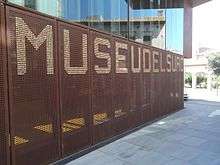The Cork Museum
The Cork Museum of Palafrugell, Spain, was created in 1972 in order to acquire, conserve, interpret and value the heritage around the cork industry in Catalonia. The cork industry has been influenced the landscape, the life and the identity of this Catalan area. The Cork Museum is part of the Costa Brava Museum Network[1] and the Network of Local Museums of Catalonia in the demarcation of Girona.[2]
The museum is located in a modernist factory around a small cork forest. The exhibition consists of an audiovisual, a journey from the forest to work at the factory to obtain plugs, discs, paper and agglomerate, a space to experiment and a space for participation.[3]

The building
The Museum is divided into three different spaces in the old factory of Can Mario. Two of them are heritage buildings (recognized as Bé Cultural d'Interès Local - BCIL, that means a cultural heritage of local interest): the industrial buildings and Cal Ganxó. The third space, newly constructed, has the main function of Reception module, installation space and warehouse.
Spaces
- Permanent exhibition. It is located in the ground floor and the first floor.
- "Manufactures" space. It is equipped in a very flexible way to accommodate exhibitions of various dimensions and with different requirements.
- Reception module. Its main function is to welcome visitors. There is also the shop of the Cork Museum.
- "Geminus" space. This space is dedicated to the workshops.
- Miquel Auditorium.
History
The origins of the Cork Museum has to be linked to the figure of the archaeologist Miquel Oliva and the local researchers Joan Badia and Albert Recasens, who founded the Palafrugell Museum in 1972. At the beginning of the 1980s the institution was divided to create the current Palafrugell archive, beginning a change to provide the museum with a monographic specialization that would respond to the interest on the cork industry.
Starting in 1986, and with the purpose of projecting a specialized museum, the first conservative square will be created. In 1989 the relationship with the National Museum of Science and Technology of Catalonia was activated, culminating in the declaration in 1995 of the Palafrugell Cork Museum as a museum-section of the previous one. Finally, in 1991, the first permanent exhibition spaces were opened at the Tarongeta street building, a rationalist-style building constructed in 1934 by Emili Blanch i Roig.
On June 29, 2012 the Palafrugell Cork Museum inaugurated a new headquarters, located in the modernist cork factory of Can Mario, being the largest museum in the specific world of this matter.[4]
Other spaces
The Cork Museum also manages the Centre d'Interpretació del Dipòsit Modernista de Can Mario[5] and the Conjunt Monumental de Sant Sebastià de la Guardia.[6] The first one guaranteed the supply and pressure of water in the old Can Mario cork factory. Over the years, it has become as a symbol of Palafrugell and has been declared Bé Cultural d'Interès Nacional - BCIN, that means a cultural heritage of national interest. In the other hand, the Conjunt Monumental de Sant Sebastià de la Guarda, you can visit the recently consolidated iberian site, the watchtower, an 18th-century hermitage and a 19th-century lighthouse.
Services and activities
The museum offers guided tours, educational activities and visits to the Centre d'Interpretació del Dipòsit Modernista de Can Mario and the Conjunt Monumental de Sant Sebastià de la Guarda.
Documentation center
The Museum has a collection of 6,200 objectis and an important cork documentation center, that has received more than 2.000 inquires.
References
- ↑ "Welcome to Cork Museum - Costa Brava Museum Network". www.museuscostabrava.cat. Retrieved 2017-08-23.
- ↑ "Xarxa de Museus Locals de Catalunya-Girona". museudelamediterrania.cat (in Catalan). Retrieved 2017-08-23.
- ↑ Consell Comarcal del Baix Empordà (2016). "Museums and collections of the Baix Empordà region" (PDF).
- ↑ Corporació Catalana de Mitjans Audiovisuals (2012). "Palafrugell estrena el Museu del Suro, el més gran del món dedicat a aquest material".
- ↑ Bruguera, Jordi. "Dipòsit modernista de Can Mario - Ajuntament de Palafrugell". www.palafrugell.cat (in Catalan). Retrieved 2017-08-23.
- ↑ Bruguera, Jordi. "Sant Sebastià de la Guarda - Ajuntament de Palafrugell". www.palafrugell.cat (in Catalan). Retrieved 2017-08-23.
Bibliography
- Fernàndez, M. (coord.) i alt. El Museu del Suro de Palafrugell. Quaderns de Didàctica i Difusió-7. Publicacions del Museu de la Ciència i de la Tècnica de Catalunya.
- ESPADALÉ, Pep: «El Museu del Suro de Palafrugell: un passat amb feina feta i un futur ambiciós». Revista del Baix Empordà, núm. 29, juny-set. 2010.